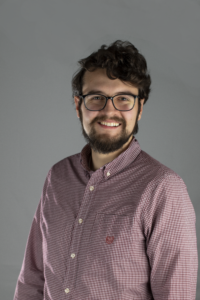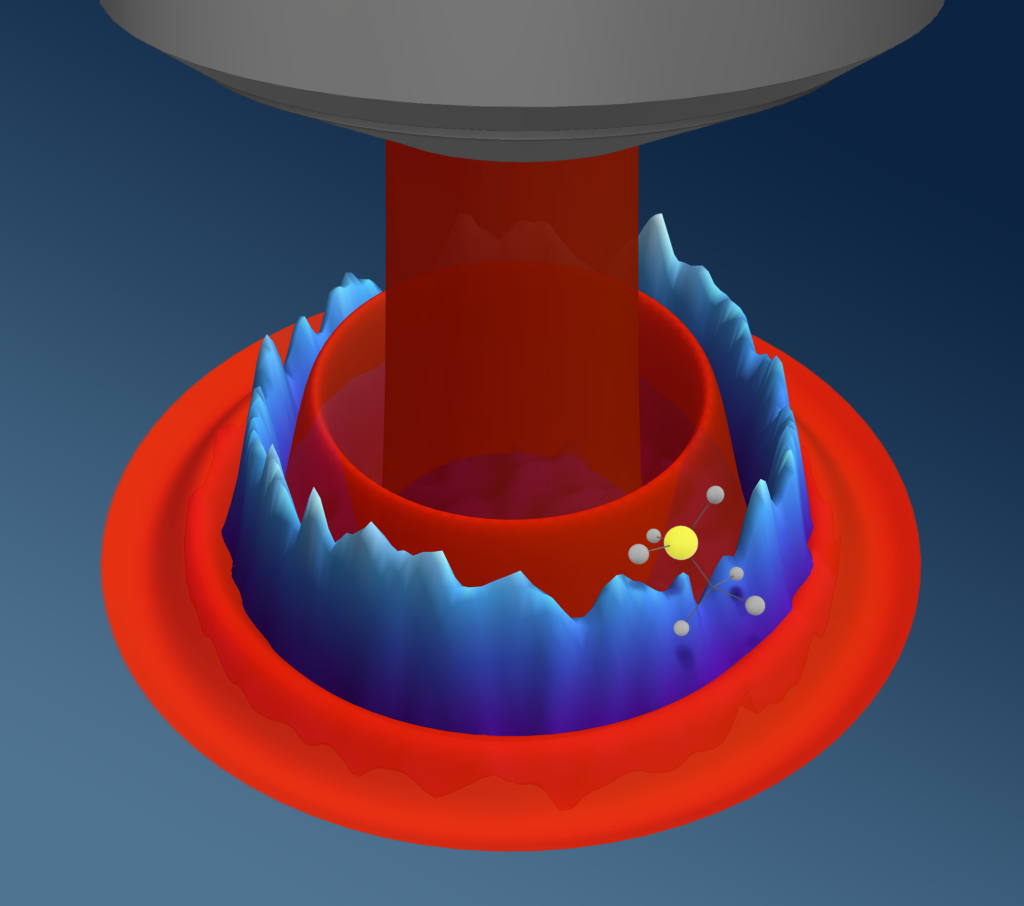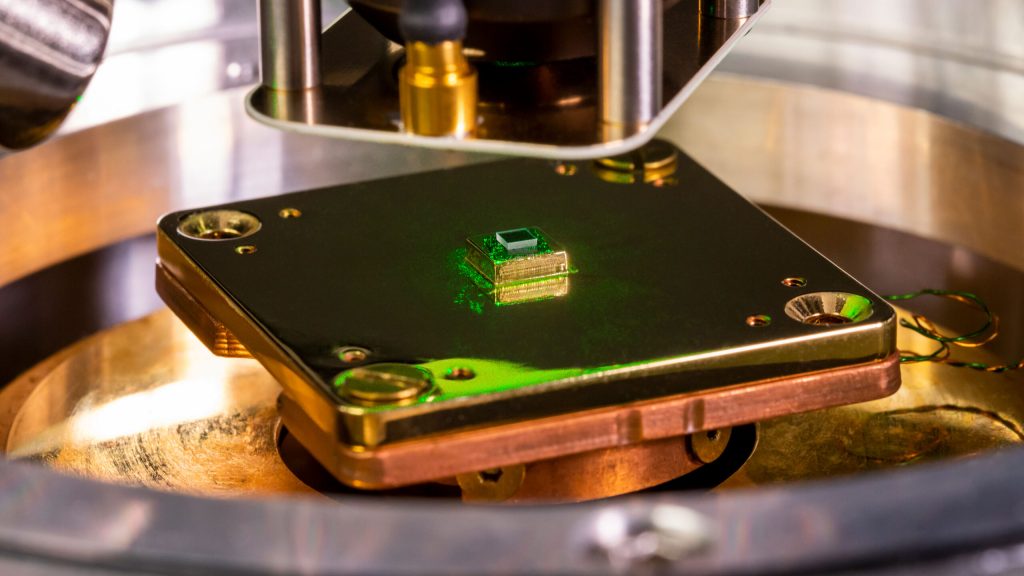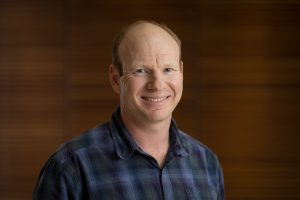The National Science Foundation has selected a proposal “Compact and robust quantum atomic sensors for timekeeping and inertial sensing” by an interdisciplinary team led by University of Wisconsin-Madison researchers for...
Read the full article at: https://engineering.wisc.edu/blog/choy-leads-team-awarded-national-science-foundation-quantum-sensing-challenge-grant/quantum sensing
Beating the diffraction limit in diamonds
by Daniel Heimsoth
Resolving very small objects that are close together is a frequent goal of scientists, making the microscope a crucial tool for research in many different fields from biology to materials science.
The resolution of even the best modern confocal microscopes — a common optical microscope popular in biology, medicine, and crystallography — is limited by an optical bound on how narrow a laser beam can be focused, known as the diffraction limit.
In a study recently published in the journal ACS Photonics, UW–Madison physics professor Shimon Kolkowitz and his group developed a method to image atomic-level defects in diamonds with super-resolution, reaching a spatial resolution fourteen times better than the diffraction limit achievable with their optics. And, because the technique uses a standard confocal microscope, this super-resolution should be available to any researchers that already have access to this common equipment.

While methods to achieve super-resolution already exist, such as stimulated emission depletion microscopy (STED), nearly all of these methods either require the addition of special optics, which can be expensive and difficult to install, or specialized samples and extensive post processing of the data. The UW–Madison technique, which they call “super-resolution Airy disk microscopy” (SAM), avoids such barriers to entry.
“You can get this all for free with the existing setup that a lot of labs already have, and it performs almost just as well,” says Aedan Gardill, a graduate student in Kolkowitz’s group and lead author of the paper. “We were able to get resolution down to twenty nanometers, which is comparable with standard techniques using [STED].”
The ‘Airy disk’ in SAM refers to a key feature of light beams that gives rise to the diffraction limit but which the researchers turned to their advantage.
Confocal microscopes use laser beams of specific wavelengths to excite matter in a sample, causing that matter to emit light. On the microscopic scale, the laser beam does not create a solid circle of light on the sample in the same way a flashlight would. Rather, light hits the object in a series of light and dark rings called an Airy pattern. Within the dark rings, the matter receives no light, which means it cannot be detected by the microscope’s light sensors.
The novelty of the SAM technique is in its two laser beam pulses, one spatially offset from the other such that the overlapping Airy patterns can distinguish between two closely spaced objects.
In their paper, the research team studied nitrogen-vacancy (NV) centers in diamond crystal, which are regions in the crystal lattice where one of two neighboring carbon atoms is replaced by a nitrogen atom, and the other is left empty. NV centers are known to have two different charge states based on how many electrons are in the defect, one that fluoresces and one that remains dark when yellow light is applied to them.
To resolve two NV centers separated by a distance less than the diffraction limit of the microscope, the SAM procedure first shines green light on them, preparing both centers into their fluorescent charge state. Then, a red laser is applied, offset such that only one of the two NV centers is in the dark ring of the Airy pattern and thus is not affected by the beam. The NV center that does see the red light is switched to the dark state.

“It goes to another dark charge state where it does not interact with yellow light,” Gardill explains. “But the initial bright charge state does interact with yellow light and will emit light.”
Finally, when the yellow laser is applied, one NV center emits light while the other does not, effectively differentiating between the two neighboring sites. By repeating these steps iteratively over a grid, the researchers could reconstruct a full image of the two nearby NVs with spectacular resolution.
The idea for this technique came as a bit of a surprise while the team was studying charge properties of NV centers in 2020.
“We tried the combinations of red-green, green-red, red-red, green-green with those first two [laser] pulses, and the one that was green then red, we ended up seeing this ring,” Gardill recounts. “And Shimon was like, ‘The width of the ring is smaller than the size of [the confocal image of] the NV. That is super-resolution.’”
This method could find wide use in many different fields, including biology and chemistry where NV centers are used as nanoscale sensors of magnetic and electric fields and of temperature in compounds and organic material. NV centers have also been studied as candidates for quantum repeaters in quantum networks, and the research team has considered the feasibility of using the SAM technique to aid in this application. Currently, the SAM method has only been applied to NV centers in diamond crystal, and more research is needed to extend its use to different systems.
That all of this can be done with hardware that many labs across the world already have access to cannot be overstated. Gardill reiterates, “If they have a basic confocal microscope and don’t want to buy another super-resolution microscope, they can utilize this technique.”
This work was supported by the U.S. Department of Energy, Office of Science, Basic Energy Sciences under Award #DE-SC0020313.
Daniel Heimsoth is a second-year PhD student in Physics. This was his first news story for the department.
New technique reveals changing shapes of magnetic noise in space and time
This article was originally published by Princeton Engineering
Electromagnetic noise poses a major problem for communications, prompting wireless carriers to invest heavily in technologies to overcome it. But for a team of scientists exploring the atomic realm, measuring tiny fluctuations in noise could hold the key to discovery.
“Noise is usually thought of as a nuisance, but physicists can learn many things by studying noise,” said Nathalie de Leon, an associate professor of electrical and computer engineering at Princeton University. “By measuring the noise in a material, they can learn its composition, its temperature, how electrons flow and interact with one another, and how spins order to form magnets. It is generally difficult to measure anything about how the noise changes in space or time.”
Using specially designed diamonds, a team of researchers at Princeton and the University of Wisconsin–Madison have developed a technique to measure noise in a material by studying correlations, and they can use this information to learn the spatial structure and time-varying nature of the noise. This technique, which relies on tracking tiny fluctuations in magnetic fields, represents a stark improvement over previous methods that averaged many separate measurements.

De Leon is a leader in the fabrication and use of highly controlled diamond structures called nitrogen-vacancy (NV) centers. These NV centers are modifications to a diamond’s lattice of carbon atoms in which a carbon is replaced by a nitrogen atom, and adjacent to it is an empty space, or vacancy, in the molecular structure. Diamonds with NV centers are one of the few tools that can measure changes in magnetic fields at the scale and speed needed for critical experiments in quantum technology and condensed matter physics.
While a single NV center allowed scientists to take detailed readings of magnetic fields, it was only when de Leon’s team worked out a method to harness multiple NV centers simultaneously that they were able to measure the spatial structure of noise in a material. This opens the door to understanding the properties of materials with bizarre quantum behaviors that until now have been analyzed only theoretically, said de Leon, the senior author of a paper describing the technique published online Dec. 22 in the journal Science.
“It’s a fundamentally new technique,” said de Leon. “It’s been clear from a theoretical perspective that it would be very powerful to be able to do this. The audience that I think is most excited about this work is condensed matter theorists, now that there’s this whole world of phenomena they might be able to characterize in a different way.”
One of these phenomena is a quantum spin liquid, a material first explored in theories nearly 50 years ago that has been difficult to characterize experimentally. In a quantum spin liquid, electrons are constantly in flux, in contrast to the solid-state stability that characterizes a typical magnetic material when cooled to a certain temperature.

“The challenging thing about a quantum spin liquid is that by definition there’s no static magnetic ordering, so you can’t just map out a magnetic field” the way you would with another type of material, said de Leon. “Until now there’s been essentially no way to directly measure these two-point magnetic field correlators, and what people have instead been doing is trying to find complicated proxies for that measurement.”
By simultaneously measuring magnetic fields at multiple points with diamond sensors, researchers can detect how electrons and their spins are moving across space and time in a material. In developing the new method, the team applied calibrated laser pulses to a diamond containing NV centers, and then detected two spikes of photon counts from a pair of NV centers — a readout of the electron spins at each center at the same point in time. Previous techniques would have taken an average of these measurements, discarding valuable information and making it impossible to distinguish the intrinsic noise of the diamond and its environment from the magnetic field signals generated by a material of interest.
“One of those two spikes is a signal we’re applying, the other is a spike from the local environment, and there’s no way to tell the difference,” said study coauthor Shimon Kolkowitz, an associate professor of physics at the University of Wisconsin–Madison. “But when we look at the correlations, the one that is correlated is from the signal we’re applying and the other is not. And we can measure that, which is something people couldn’t measure before.”
Kolkowitz and de Leon met as Ph.D. students at Harvard University, and have been in touch frequently since then. Their research collaboration arose early in the COVID-19 pandemic, when laboratory research slowed, but long-distance collaboration became more attractive as most interactions took place over Zoom, said de Leon.
Jared Rovny, the study’s lead author and a postdoctoral research associate in de Leon’s group, led both the theoretical and experimental work on the new method. Contributions by Kolkowitz and his team were critical to designing the experiments and understanding the data, said de Leon. The paper’s coauthors also included Ahmed Abdalla and Laura Futamura, who conducted summer research with de Leon’s team in 2021 and 2022, respectively, as interns in the Quantum Undergraduate Research at IBM and Princeton (QURIP) program, which de Leon cofounded in 2019.
The article, Nanoscale covariance magnetometry with diamond quantum sensors, was published online Dec. 22 in Science. Other coauthors were Zhiyang Yuan, a Ph.D. student at Princeton; Mattias Fitzpatrick, who earned a Ph.D. at Princeton in 2019 and was a postdoctoral research fellow in de Leon’s group (now an assistant professor at Dartmouth’s Thayer School of Engineering); and Carter Fox and Matthew Carl Cambria of the University of Wisconsin–Madison. Support for the research was provided in part by the U.S. National Science Foundation, the U.S. Department of Energy, the Princeton Catalysis Initiative and the Princeton Quantum Initiative.
The University of Wisconsin–Madison’s Department of Physics contributed to this article.